Edgar Rice Burroughs’s Mars, Part 3: The Warlord of Mars
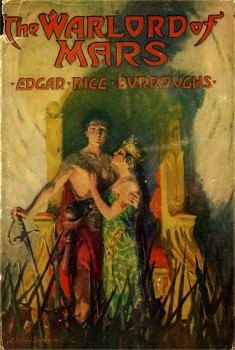 Although there are still eight more books to go in the Mars series, with The Warlord of Mars I can bring to a conclusion Phase #1 of the saga: this completes the “John Carter Trilogy,” and the books that follow it take different paths with new heroes. John Carter will not return to the protagonist role until the eighth book, Swords of Mars, published twenty-one years later.
Although there are still eight more books to go in the Mars series, with The Warlord of Mars I can bring to a conclusion Phase #1 of the saga: this completes the “John Carter Trilogy,” and the books that follow it take different paths with new heroes. John Carter will not return to the protagonist role until the eighth book, Swords of Mars, published twenty-one years later.
At the end of the thrill-ride of The Gods of Mars, John Carter lost his love Dejah Thoris in the Chamber of the Sun within the Temple of Issus. A whole year must pass before the slow rotation of the chamber will allow Dejah Thoris to escape. She may not even be alive, since the last moments that John Carter witnessed, the jealous thern woman Phaidor was ready to stab Carter’s love. Did she kill Dejah Thoris? Or did the noble Thuvia take the blow instead?
Readers hung on through the middle of 1913 until Burroughs brought a conclusion to the John Carter epic at the end of the year and made his hero into The Warlord of Mars.
Our Saga: The adventures of Earthman John Carter, his progeny, and sundry other natives and visitors, on the planet Mars, known to its inhabitants as Barsoom. A dry and slowly dying world, Barsoom contains four different human civilizations, one non-human one, a scattering of science among swashbuckling, and a plethora of religions, mystery cities, and strange beasts. The series spans 1912 to 1964 with nine novels, one volume of linked novellas, and two unrelated novellas.
Today’s Installment: The Warlord of Mars (1913–14)
Previous Installments: A Princess of Mars (1912), The Gods of Mars (1913)
The Backstory
With a cliffhanger ending to The Gods of Mars, Burroughs was ready to roll with the conclusion. It was a ferociously busy time in his life: All-Story rejected his second Tarzan novel — one of the most comically blockheaded decisions in the history of magazine fiction; he quit his day job and became a full-time author; his third son John Coleman Burroughs was born; days later, his father George Tyler Burroughs died. In the middle of all this, ERB plunged back to working on Mars. He never developed an outline for the trilogy, and so he took the wrap-up of John Carter’s story as it came, daydreaming down on paper.
Burroughs submitted the completed book as Prince of Helium to Thomas Newell Metcalf at Munsey’s Magazines on 6 June 1913. Burroughs apparently had trouble settling on a title the book, since he at various times suggested Yellow Men of Barsoom, The Fighting Prince of Mars, and Across Savage Mars. I especially like that last one. At 60,000 words, it was the shortest of Martian novels so far. (Gods of Mars came in at 86,000 words, and A Princess of Mars at 72,000 words.)
The serialized version in All-Story December 1913–March 1913, appeared under the title of Warlord of Mars, no definite article. A. C. McClurg published it in hardback in 1919 with the definite article at the front.
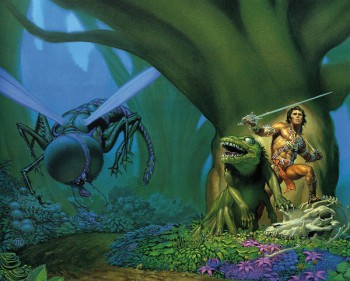 The Story
The Story
Since the story comes straight from a cliffhanger ending, there is no framing device with the fictional Edgar Rice Burroughs as with the previous books. John Carter is already on Mars, and his love Dejah Thoris is trapped for a year within the slow-rotation of the Temple of the Sun. Six months have passed since the armies of Helium and Thark destroyed the power of the First Born and the Holy Therns, and John Carter’s son Carthoris sits on the throne of Helium while Carter travels around the south polar region near to where his beloved Dejah Thoris is imprisoned with the murderous Phaidor, daughter of the Father of the Therns, Matai Shang. Another six months must pass before the rotating chamber will release Dejah Thoris and Thuvia of Ptarth — if Phaidor did not kill them.
John Carter is rowing on the river Iss with his faithful calot Woola when he overhears plotting between his First Born guide, Thurid, and Matai Shang against him. John Carter discovers from their plans that a secret passage exists into the Temple of the Sun. He finds his way inside, but Thurid and Matai Shang beat him there and escape with Thuvia and Dejah Thoris as their prisoners.
John Carter enters Matai Shang’s hideout in the Otz Mountains to rescue the kidnapped women. When Matai Shang escapes with his hostages on a flier, John pursues in a commandeered vehicle. A lucky shot from Thurid’s pistol blows out the buoyancy tanks on Carter and Woola’s ship, and they make a forced landing in the equatorial forests of Kaol.
Carter tries to enter the city of the Jed of Kaol, Kulan Tith, since he believes that Matai Shang has sought refuge there with his prisoners. Carter helps the red men of the city defeat an ambush of green men, and receives an invitation into the city from Kulan Tith. He finds that Matai Shang is indeed there, with Dejah Thoris and Thuvia still captive. When the visiting Jeddak of Ptarth, Thuvia’s father Thuvan Dihn, joins John Carter to demand Matai Shang handover his two prisoners, the Holy Thern and his First Born ally make an escape on a flier toward the north. John Carter, along with Thuvan Dihn and Woola, chase after them, but crash their craft before the ice walls around the northern pole.
With Woola dispatched to Helium with a message to Carthoris, John Carter and Thuvan Dihn pass through the Carrion Caves under the ice walls and find the land of Okar, abode of the fabled yellow men — the fourth of the four dominate races on the planet. John Carter suspects that not only are Dejah Thoris and Thuvia somewhere in the cities of Okar, but the missing Jeddak of Helium and his son (both vanished since before the events of The Gods of Mars) may also be here. Rescuing them will lead to the restoration of Helium’s power over the planet, with John Carter taking the special title on the cover of the book.
The Positives
Yeah, Woola is back! Let’s hear it for faithful Martian dog(-like) companions!
The Gods of Mars saw Barsoom ripped apart as the nation of Helium turned against two false religious groups, and concluded with the power of the cults destroyed. The Warlord of Mars tells the important follow-up story of the rebuilding in the wake of the destruction of the mendacious rulers. John Carter helped smash apart one order, and here he helps create the new one. (With him at the top, of course.) Thus the three first novels form a thematically complete trilogy, and even though Burroughs liked to write with little planning and go with his gut instincts, The Warlord of Mars feels like the right conclusion to John Carter’s story. And Barsoom’s as well … although that only for a brief time.
The glory at the conclusion of the novel, especially after its satisfying action finale, is a moving one. Through these three books, we’ve witnessed not only the triumph of John Carter as a hero in a new world, but the triumph of Mars:
Twenty-two years before I had been cast, naked and a stranger, into this strange and savage world. The hand of every race and nation was raised in continual strife and warring against the men of every other land and color. Today, by the might of my sword and the loyalty of the friends my sword had made for me, black man and white, red man and green rubbed shoulders in peace and good-fellowship. All the nations of Barsoom were not yet as one, but a great stride forward toward that goal had been taken, and now if I could but cement the fierce yellow race into this sodality of nations I should feel that I had rounded out a great lifework, and repaid to Mars at least a portion of the immense debt of gratitude I owed her for having given me my Dejah Thoris.
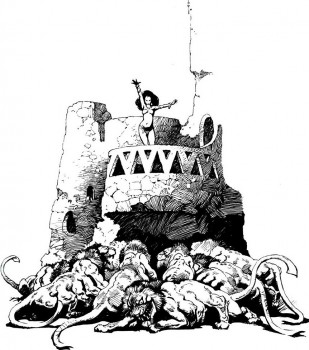 I am a total sucker for a speech like this. Yes, John Carter used the sword to bring nations together, and that isn’t quite the lesson I would teach about world peace, but this is a pulp epic about Mars and I can’t help but feel a bit overwhelmed at the close of this story, satisfied that a great good has been achieved on a dying and fractious world.
I am a total sucker for a speech like this. Yes, John Carter used the sword to bring nations together, and that isn’t quite the lesson I would teach about world peace, but this is a pulp epic about Mars and I can’t help but feel a bit overwhelmed at the close of this story, satisfied that a great good has been achieved on a dying and fractious world.
Stepping back from the grand themes presented in the conclusion: This is the most linear and easy to follow plot yet in the Martian books, and it makes the novel easy to zip through — it’s an even faster read than The Gods of Mars, which has a larger cast and overlapping plot strands. Burroughs shows no sign of running out of creative obstacles to hurl at his hero either.
Matai Shang, the leader of the Holy Therns, is the main adversary throughout, with his First Born stooge Thurid constantly with him. The previous two books did not have a consistent personal villain guiding the whole story, and although neither required one, The Warlord of Mars benefits from these developed baddies keeping the momentum going.
Although The Warlord of Mars lacks the frenzied action pace of its predecessor, it does have sequences that show Burroughs trying new way to generate tension aside from writing another pitched battle scene. Carter uses his brain to figure out the radium light code that allows him to access the secret passageway into the Temple of the Sun, and the time spent on this sequence is worthwhile because it gives the hero a different kind of challenge.
Another excellent use of suspense is John Carter and Thuvan Dihn trying to cross through a herd of sleeping apts in the Carrion Caves. Another massive fight between Carter and legions of foes would be tedious, so the selection of stealth is a good change-up in pace. Also interesting is the Pit of Plenty into which Salensus Oll, Jeddak of Okar, drops Carter. The boilerplate villain tactic in an ERB story is putting the hero into an arena battle, or trapping him with a vicious beast; but the Pit of Plenty is psychological torment that uses a Tantalus scheme of driving a prisoner mad with visions of food and water. (Salensus Oll does eventually lower an apt into the pit, but Carter is already on his way out at the point. Gotta move faster than that, Oll.)
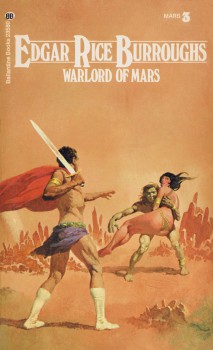 The best duel in the series so far occurs when John Carter faces Solan, the yellow Martian who guards a lever that controls the magnet that will disable the incoming ships of Helium. The details of the fight make it a nail-biter, especially since Carter expected that the elderly Solan would fall fast to his sword. Solan ends up knowing the science of the blade as well as John Carter. This is the best example in the book of how Burroughs was still evolving as an action writer.
The best duel in the series so far occurs when John Carter faces Solan, the yellow Martian who guards a lever that controls the magnet that will disable the incoming ships of Helium. The details of the fight make it a nail-biter, especially since Carter expected that the elderly Solan would fall fast to his sword. Solan ends up knowing the science of the blade as well as John Carter. This is the best example in the book of how Burroughs was still evolving as an action writer.
The finale in Kadabra, the capital of Okar, is fantastic. There is no way to outdo the scope of the end of the previous book, so Burroughs wrote a slimmed down battle that wisely focuses on John Carter’s individual heroics trying to get Dejah Thoris away from Thurid. The character twist that happens in the climatic moment is a great device: satisfying, tragic, and completely in step with the developments in The Gods of Mars.
Dejah Thoris gets a chance to rescue her lover for a change: she uses a special whistling call to stop a pack of banths from killing Carter inside Matai Shang’s hideout. It’s a short moment in a novel where she otherwise spends 98% of her time as an abductee, but it stands out.
The Negatives
Following up the epic and relentless excitement of The Gods of Mars is asking a lot from any writer, and Burroughs was not completely up to task. Perhaps the crowding of events in his life wore him down. The Warlord of Mars is a fine science-fantasy adventure, but there is a touch of exhaustion to it. A reader who comes to it directly after reading The Gods of Mars may feel a bit exhausted as well. The glorious insanity has taken a vacation, and solid adventure is filling in.
The narrative is back to “pursue the princess,” soon to be Burroughs’s business-as-usual. The uniting of the planet only emerges at the end, and until then the plot is John Carter chasing after Matai Shang and his two prisoners, losing them, and then managing to pick the exact right place to search for them again.
This is the first Martian novel to take place entirely on Mars, without even a prologue from the point of view of the pseudo-ERB. This may sound like a trivial detail, but I’ve always found these framing devices have a powerful effect on the story, giving a sense of tale-telling and a sheen of veracity to them. The cold opening of The Warlord of Mars, with no re-introduction to John Carter, is a touch disappointing.
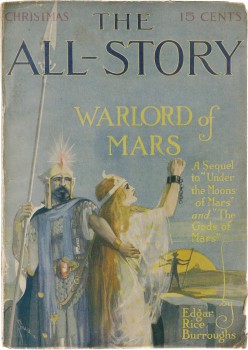 Okar, the country of the yellow Martians, is anticlimatic after the gonzo eccentricity of the Valley of Dor and the Sea of Omean. ERB makes it the locale of great action, but the place itself isn’t at all noteworthy, and psychologically the yellow Martians aren’t much different from the red Martians.
Okar, the country of the yellow Martians, is anticlimatic after the gonzo eccentricity of the Valley of Dor and the Sea of Omean. ERB makes it the locale of great action, but the place itself isn’t at all noteworthy, and psychologically the yellow Martians aren’t much different from the red Martians.
The forested land around Kaol is the first piece of Martian topography that doesn’t feel right. The bizarre splendors of the Valley of Dor made sense as a region locked away behind giant polar mountains, but a lush wooded region in the center of a planet that is otherwise dry lands reeks of variety for its own sake.
I’m glad Burroughs chose to end John Carter’s epic here and find new heroes for the next four novels, because Carter finally reaches an apex of pomposity that threatens to undermine him. John Carter is the greatest warrior on two worlds, John Carter can take down anybody, John Carter can best hordes without getting a single scratch, John Carter is the most heroic person in the entire universe. Yeah, John, thanks. You’re totally awesome. Now shut up and get back to work.
And what does Carter mean when he claims he’s the greatest fighter of “two worlds”? Maybe the best on Mars, because he has the benefit of its lesser gravity. But how impressive was he on Earth? All evidence points to him having a standard career in the Confederate Army. He certainly didn’t take down hundreds of enemies at once.
Finally, it is simply slipshod civic planning to build a lever that will destroy your entire city with one pull. Whose idea was that civic improvement?
Craziest bit of Burroughsian Writing: See below.
Best Moment of Heroic Arrogance: For all his reckless charges against hundreds of opponents, John Carter reaches the pinnacle of braggadocio with this statement: “If I sometimes seem to take too great pride in my fighting ability, it must be remembered that fighting is my vocation. If your vocation is shoeing horses, or painting pictures, and you can do one or the other better than your fellows, then you are a fool if you are not proud of your ability. And so I am very proud that upon two planets no greater fighter has ever lived than John Carter, Prince of Helium.”
Times a “Princess” (Female Lead) Gets Kidnapped: 3 (6 if we count Thuvia, who is always with Dejah Thoris)
Best Creature: The apt: a snow beast with six legs, a head like a hippopotamus, great tusks, and multifaceted eyes.
Most Imaginative Idea: The Pit of Plenty
Sometimes the Costume Wears You: John Carter paints his skin yellow and wears a false bushy beard and mustache to pass for a man of Okar, but is heartbroken that Dejah Thoris doesn’t recognize him from across the room, and believes this is a sign of rejection. Carter loses some bragging rights because of this.
Should ERB Have Continued the Series? The tale of John Carter is over, but with a whole world to play with, why not?
Next: Thuvia, Maid of Mars
Ryan Harvey is a veteran blogger for Black Gate and an award-winning science-fiction and fantasy author. He received the Writers of the Future Award in 2011 for his short story “An Acolyte of Black Spires,” and has two stories forthcoming in Black Gate, as well as a currently available e-book in the same setting. He also knows Godzilla personally. You can keep up with him at his website, www.RyanHarveyWriter.com, and follow him on Twitter.
Warlord of Mars may be laden with flaws, but I recall none of them. I was eleven years old when I read it, staying up past my bedtime in secret, reading late into the night during some timeless expanse of summer vacation. When I finished it I was literally stunned by how glorious it was. I got out of bed and wandered aimlessly through my dark and silent home, visions of Barsoom flickering and falling about me. I don’t remember going back to sleep.
For me, that was maybe THE quintessential Youthful Reading Experience. A magical moment that insured both that I’d always find something in reading that I would find nowhere else, and that I was doomed, as an older and more experienced reader, to seek another such moment in vain.
I know the feeling, Chris. But for me, it was The Gods of Mars and Tarzan of the Apes that did it. I couldn’t recapture it with The Warlord of Mars.
[…] Carter’s story appeared finished with The Warlord of Mars. But readers wanted more, and Burroughs was fired with productive energy. Less than a year after […]
[…] Installments: A Princess of Mars (1912), The Gods of Mars (1913), The Warlord of Mars (1913-14), Thuvia, Maid of Mars […]
[…] Installments: A Princess of Mars (1912), The Gods of Mars (1913), The Warlord of Mars (1913-14), Thuvia, Maid of Mars (1916), The Chessmen of Mars […]
[…] Installments: A Princess of Mars (1912), The Gods of Mars (1913), The Warlord of Mars (1913–14), Thuvia, Maid of Mars (1916), The Chessmen of Mars (1922), The Master Mind of Mars […]
[…] Installments: A Princess of Mars (1912), The Gods of Mars (1913), The Warlord of Mars (1913–14), Thuvia, Maid of Mars (1916), The Chessmen of Mars (1922), The Master Mind of Mars […]
[…] Installments: A Princess of Mars (1912), The Gods of Mars (1913), The Warlord of Mars (191314), Thuvia, Maid of Mars (1916), The Chessmen of Mars (1922), The Master Mind of Mars (1927), […]
[…] return to the icy north, the reappearance of the monstrous apts that were one of the best parts of The Warlord of Mars, and cameos from old characters. Seeing Tan Hadron, hero of A Fighting Man of Mars, pop up aboard […]
[…] Installments: A Princess of Mars (1912), The Gods of Mars (1913), The Warlord of Mars (1913–14), Thuvia, Maid of Mars (1916), The Chessmen of Mars (1922), The Master Mind of Mars […]
[…] they are defeated, or else they eventually switch allegiances; Phaidor in The Gods of Mars and The Warlord of Mars is the best example of the latter. But at his finest, Burroughs doesn’t need such prominent […]